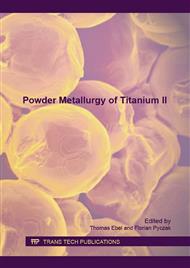p.260
p.271
p.282
p.287
p.293
p.302
p.311
p.318
p.325
Processing TiROTM Powder for Strip Production and other Powder Consolidation Applications
Abstract:
The TiROTM process has been developed at CSIRO for the continuous direct production of Ti powder. The process has two main steps; a reaction step where the Ti is produced as very fine particles dispersed in larger particles of magnesium chloride. The MgCl2 is separated from the Ti powder in a continuous vacuum distillation unit. The Ti product from this unit comprises a lightly sintered “biscuit” of Ti particles that can be broken up into individual particles powder with a d50 around 200 μm. These particles have a unique morphology which is a function of the process.For many powder metallurgical applications TiROTM powder will require further processing to tailor its morphology for the specific application. A small sample of Ti strip has been produced from ring milled TiROTM powder by a CSIRO patented combination of direct powder rolling (DPR) followed by hot roll densification (HRD). The Ti strip was annealed and characterised in terms of microstructure and chemistry.A powder manipulation technology (PMT) has been developed to modify TIROTM particulates without the need of more expensive hydride-dehydride (HDH) or gas atomization routes to improve density, flowability, size, distribution and shape for cold spray and additive manufacturing applications.
Info:
Periodical:
Pages:
293-301
Citation:
Online since:
August 2016
Authors:
Keywords:
Price:
Сopyright:
© 2016 Trans Tech Publications Ltd. All Rights Reserved
Share:
Citation:


